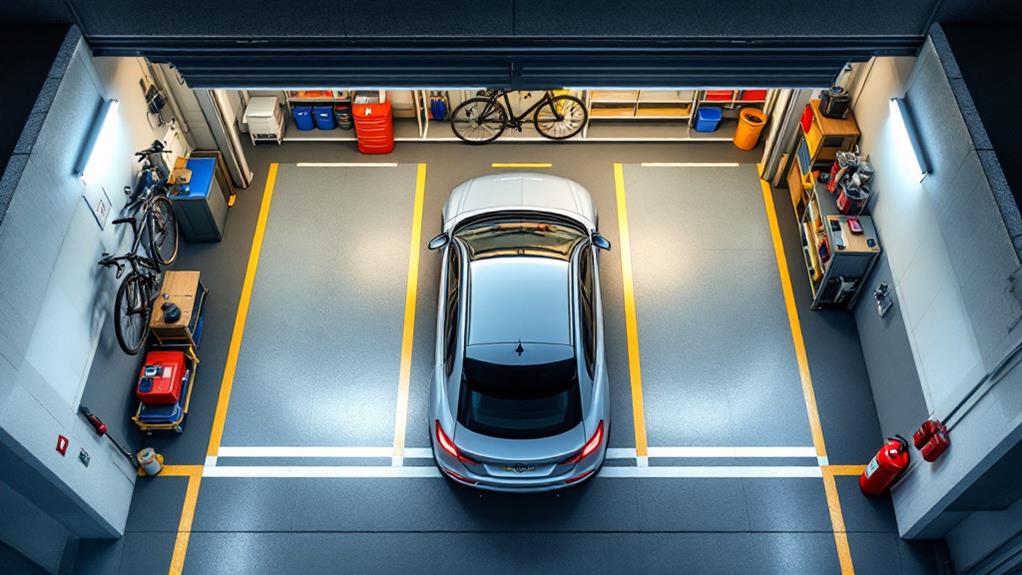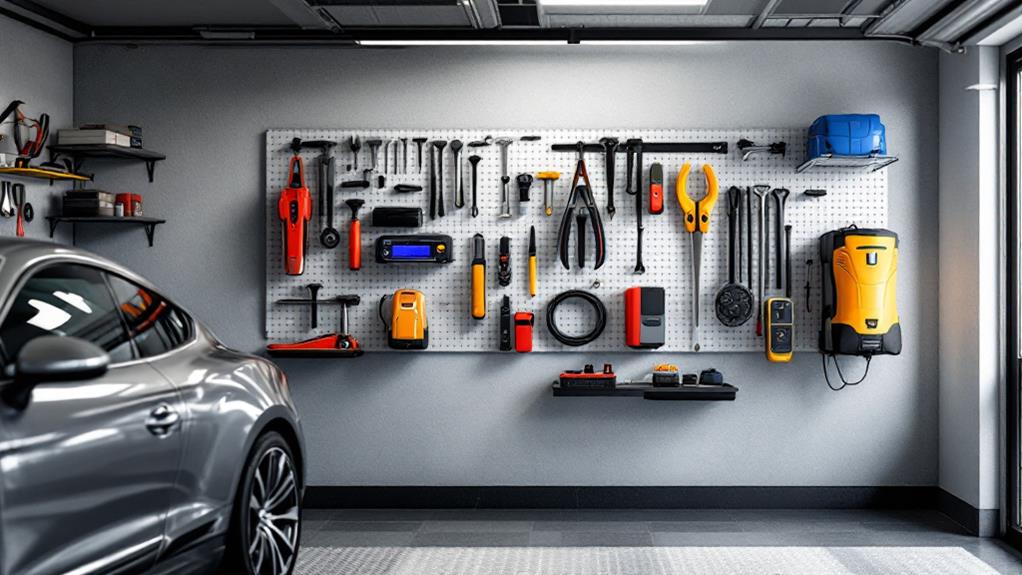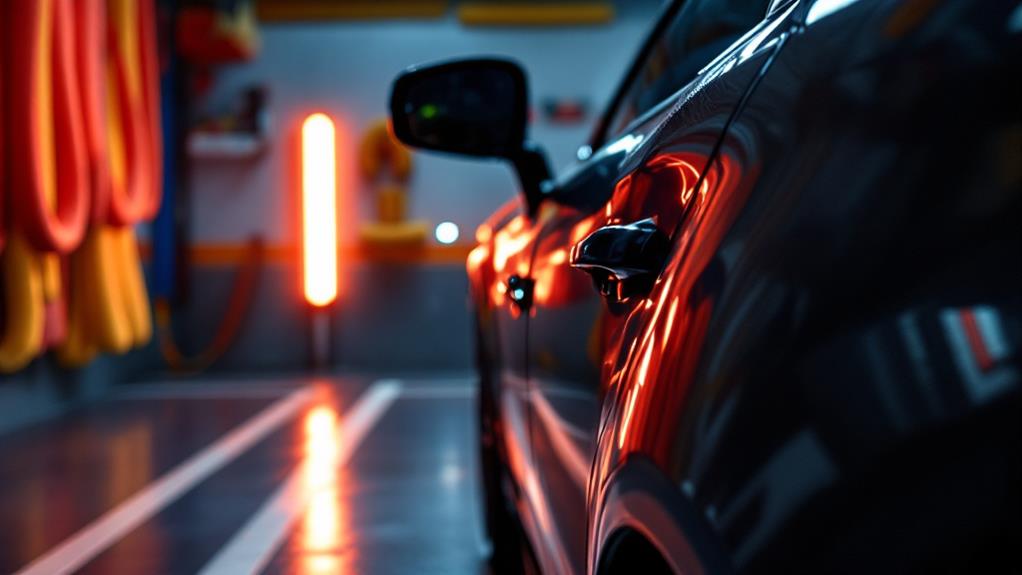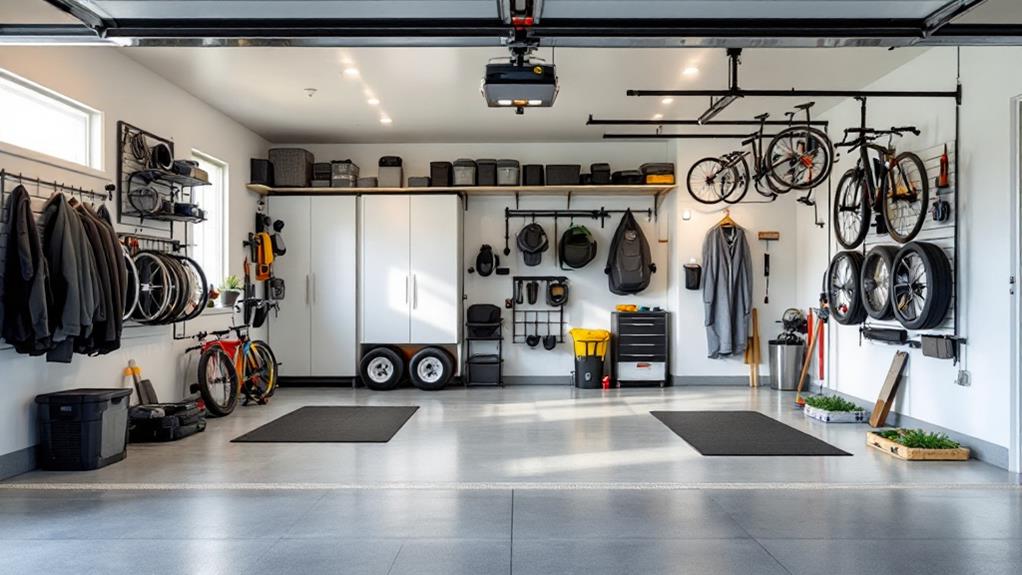How to Set Up a Home Garage for Easy In-and-Out Parking

To set up your home garage for easy in-and-out parking, start by evaluating your space and decluttering. Optimize the layout by creating distinct zones and utilizing vertical storage solutions. Install efficient storage systems like wall-mounted units and overhead racks to maximize space. Implement parking assistance tools such as bumper blocks or sensors to guide your vehicle. Upgrade your garage door system for improved accessibility and energy efficiency. Create clear pathways and practice precision parking techniques. Don't forget to enhance lighting for better visibility. With these steps, you'll convert your garage into a well-organized space that makes parking a breeze. Find more ways to perfect your garage setup below.
Assess Your Garage Space
When it comes to home garage parking, evaluating your garage space is indispensable. Start by measuring your garage's dimensions to determine if it meets the recommended minimum sizes for your parking needs. For a 1-car garage, you'll want at least 12' x 24', while a 2-car garage should be at least 22' x 24'.
Consider how you'll use your garage. If it's solely for parking, you might be able to work with smaller dimensions. However, if you need additional storage space, opt for larger sizes like 16' x 24' for a 1-car garage or 24' x 24' for a 2-car setup.
Keep in mind that the most popular minimum-sized 2-car garage is 18x21 (378 square feet), while the average-sized 2-car garage is 20x21 (420 square feet). If you're working with a small garage, careful planning is essential for parking two cars comfortably.
As you assess your space, think about how you'll maneuver your vehicles in and out. Consider factors like door placement, storage needs, and any potential obstacles. By thoroughly evaluating your garage's dimensions and layout, you'll be better equipped to create an efficient parking setup for your home.
Declutter and Organize
After evaluating your garage space, it's time to declutter and organize. Start by conducting a thorough cleanup, removing unnecessary items to create more available parking space. This process will help you visualize your garage's potential and identify areas for improvement.
Next, focus on maximizing vertical space with wall-mounted storage solutions. Install shelves, pegboards, and slatwall systems along the side wall to keep items off the garage floor. Employ overhead storage racks for seldom-used items, keeping the floor clear for easy maneuvering around your vehicle.
Implement a garage cabinet system with labeled drawers and adjustable shelves for organized storage. Group similar items together and label storage areas to maintain a clutter-free and efficient garage layout. This will make it easier to find what you need and keep your garage tidy.
To depict an organized garage, imagine:
- Clear garage floor with ample parking space
- Neatly arranged tools on wall-mounted pegboards
- Labeled cabinets and drawers for easy item retrieval
Optimize Garage Layout
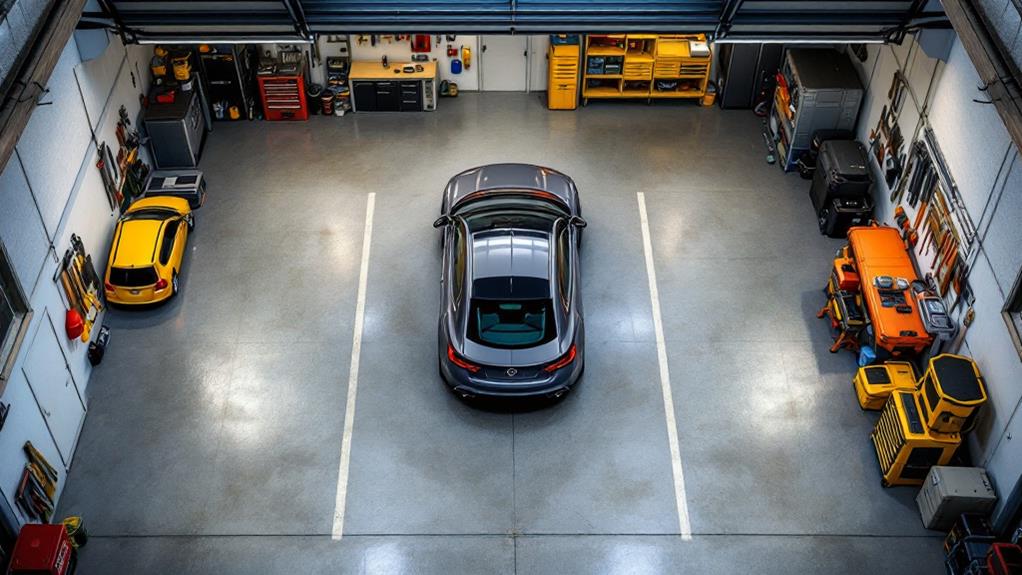
Your garage's layout plays an essential role in maximizing its functionality. To make Home Garage Parking Easier, start by creating distinct zones for parking, storage, and work areas. This arrangement will help you park more efficiently and access your belongings with ease.
Place frequently used items near the garage door for quick retrieval. Group similar items together to streamline your organization and make finding what you need a breeze. Don't forget to employ corners and unused spaces for additional storage solutions, maximizing every inch of available space.
Consider incorporating multi-purpose furniture and equipment to enhance your garage's efficiency. For example, a workbench with built-in storage can serve as both a workspace and a storage unit. To make parking Easier, install garage parking aids such as laser guides or parking mats. These tools will help you park accurately every time, avoiding potential collisions with stored items or walls.
Install Efficient Storage Solutions
How can you maximize your garage's potential for both parking and storage? The key lies in installing efficient storage solutions that keep your belongings organized while freeing up precious floor space. Start by utilizing wall-mounted storage units and overhead storage racks to take advantage of vertical space. These options allow you to store items off the floor, creating more room for your vehicles.
Invest in a space-saving workbench or tool chest with multiple drawers to keep your tools and equipment neatly organized. For easy access to frequently used items, consider installing pegboards or magnetic strips on the walls. These versatile storage solutions help you maintain a clutter-free environment while keeping essential tools within reach.
To further optimize your garage's layout, consider the following:
- Install sliding or folding garage doors to save floor space and improve maneuverability
- Use modular shelving units that can be easily reconfigured as your storage needs change
- Implement a labeling system for storage containers to quickly locate items when needed
Implement Parking Assistance Tools
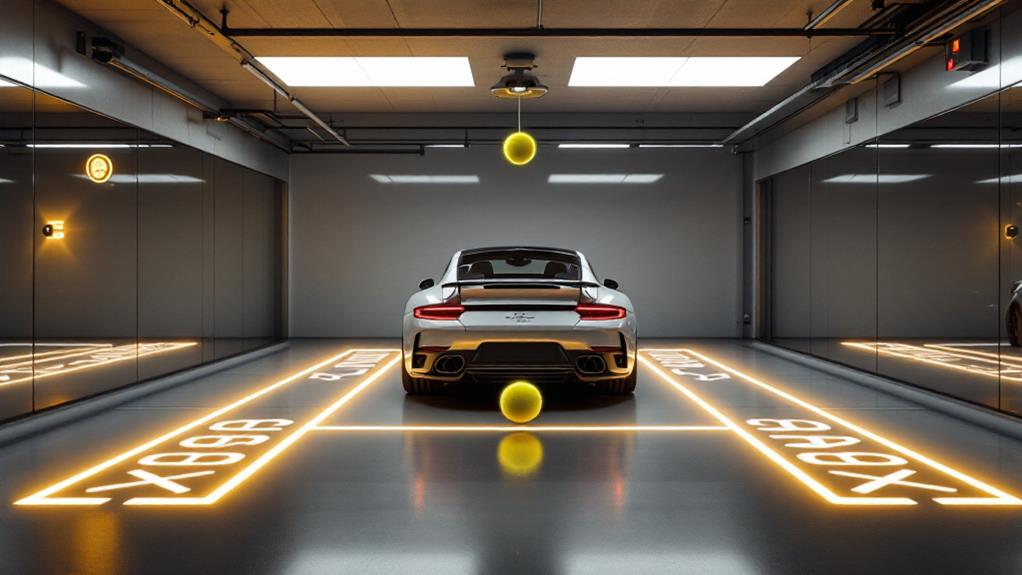
To make parking in your garage a breeze, implementing parking assistance tools can be an impactful solution. Start by installing parking aids like bumper blocks or garage parking sensors to guide your vehicle into the perfect parking spot. These tools help you position your car accurately, preventing damage to your side mirrors or garage walls.
A garage door opener with remote access offers convenience, allowing you to open and close the door without leaving your vehicle. To enhance safety, invest in a garage door tilt sensor that automatically stops the door from closing if your car is in the way.
Consider implementing a garage parking mat with built-in positioning markers. This visual guide makes it easy to park consistently in the same spot every time. For added precision, attach a dashboard-mounted parking aid that provides distance measurements and visual cues as you maneuver your vehicle.
Don't forget about lighting in your garage. Proper illumination is vital for safe parking, especially during nighttime. Install bright, energy-efficient lights to guarantee you can see clearly when entering and exiting your garage. With these garage parking aids in place, you'll make parking a stress-free experience and protect your vehicle from accidental bumps and scrapes.
Enhance Garage Lighting
For a safer and more functional garage, proper lighting is essential. Enhancing your garage lighting isn't just about brightness; it's about creating a space that's both efficient and comfortable for parking and other activities. To achieve this, consider installing energy-efficient LED fixtures throughout your garage. These lights consume much less energy while providing excellent visibility, making them a smart choice for any DIY parking aids you might use.
Position motion-activated lights strategically to automatically illuminate your garage when you enter. This is particularly helpful when your hands are full or when you're trying to move around a tennis ball hanging from the ceiling. Incorporate dimmable controls to adjust brightness levels based on your needs, whether you're working on a project or simply parking your car.
To further enhance your garage lighting:
- Use a combination of overhead lights and task lighting for thorough illumination
- Install skylights or windows to maximize natural light during the day
- Add under-cabinet or workbench lighting for specific work areas
These Solutions to Make Home garage parking easier will not only improve visibility but also create a more inviting space. Remember, good lighting on the side walls and corners can help prevent accidental bumps and scrapes when maneuvering your vehicle.
Upgrade Garage Door System
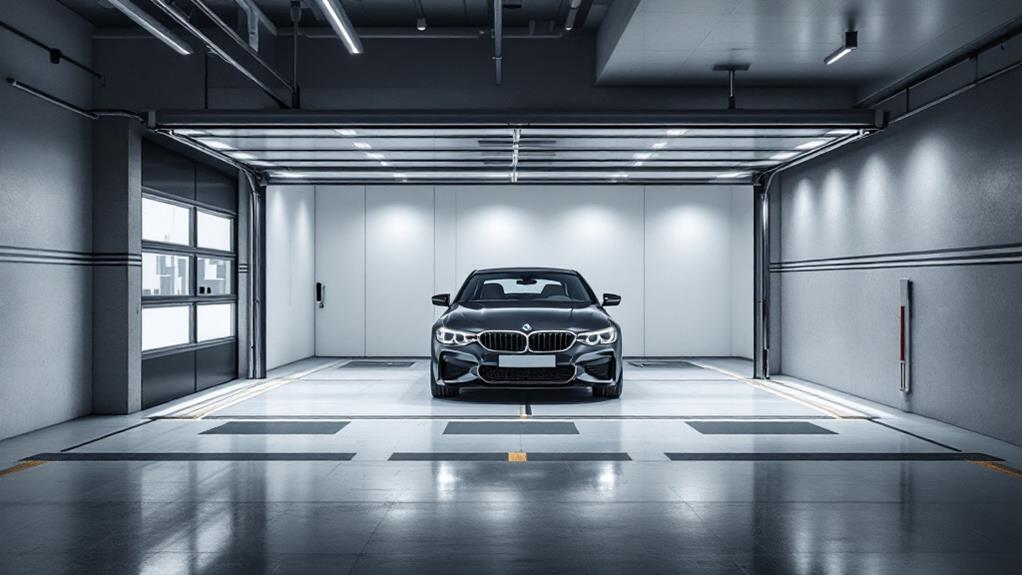
With your garage illuminated, it's time to focus on another key element: your garage door system. To ascertain your car garage functions smoothly, consider upgrading to a modern, quiet, and energy-efficient opener. Look for models with remote access and essential safety features like auto-reverse and photo-eye sensors. When planning a new garage or renovating an existing one, work with a garage builder to install a high-quality door with wide clearance, accommodating larger vehicles and improving accessibility.
Replace old, worn-out doors with insulated models to enhance energy efficiency and reduce noise. Incorporate a tilt sensor to prevent collisions and damage during opening or closing. This small addition can save you from costly repairs and guarantee your garage door operates safely.
Don't forget to regularly maintain and inspect your garage door mechanism. This practice will confirm smooth operation and extend its lifespan. By upgrading your garage door system, you'll create a more functional and secure space for your vehicles. Remember, a well-designed garage door is like the cherry on top – or in this case, the ball from the ceiling that guides you to the perfect parking spot.
Create Clear Pathways
Creating clear pathways in your garage is essential for safe and efficient parking. To Make Home Garage Parking easier, you'll want to remove unnecessary items from the main traffic areas. Position frequently used tools and equipment along the garage's perimeter, keeping the center clear for driving forward and maneuvering. This approach guarantees you'll have enough room to park two vehicles comfortably.
Utilize vertical storage solutions like pegboards or slatwall panels to hang tools and free up important floor space. Incorporate mobile or retractable storage options, such as workbenches or tool chests, allowing for flexible rearrangement as needed. Remember to maintain a minimum size clearance of 3-4 feet between parked vehicles and any obstructions.
To visualize the ideal garage layout:
- Clear center area for easy vehicle maneuvering
- Frequently used items organized along walls
- Vertical storage systems maximizing space efficiency
Utilize Vertical Space
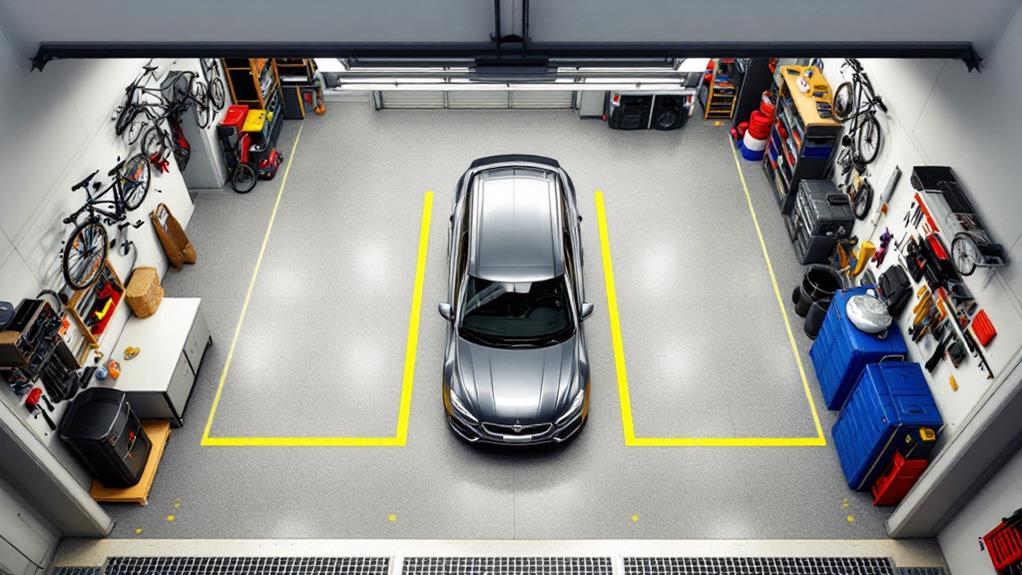
Your garage's vertical space offers untapped potential for maximizing storage and improving parking efficiency. By utilizing this often-overlooked area, you'll help make parking easier and create more room for your vehicles.
Start by installing overhead storage racks for seldom-used items. This keeps the floor clear and makes it easier to maneuver your car, especially in a standard 20' wide by 24' deep garage. Next, implement wall-mounted slatwall organization systems to hang tools, sports equipment, and other gear. This frees up essential floor space and keeps everything within easy reach.
Incorporate adjustable shelving units along the walls to neatly store smaller items and organize them by category. For a more inclusive solution, consider a garage cabinet system with pull-out drawers. This optimizes storage for various items while maintaining a clean, organized appearance.
Mount a pegboard on the walls to create a customizable tool organization solution. This not only frees up floor space but also allows you to easily rearrange your tools as needed. Finally, don't forget to add foam pads or a parking guide to protect your car and help you park precisely every time.
Practice Precision Parking Techniques
Commanding precision parking techniques is essential for maximizing your garage space and ensuring your vehicle fits comfortably. To make your garage much easier to traverse, practice these methods to park the car with accuracy every time.
One effective technique is the ball on a string method. Hang a tennis ball from the ceiling so it touches your windshield when you're in the perfect spot. This visual cue helps you park consistently in the same position. For small garages, consider using parking guides on the floor. Paint lines or install rubber strips to mark your ideal tire placement, allowing you to align your vehicle perfectly each time.
To further improve your parking precision:
- Use side mirrors to align your car with wall markings or objects
- Practice reversing into your spot for better maneuverability when leaving
- Install proximity sensors or backup cameras for added spatial awareness
